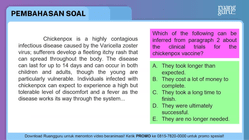Iklan
Pertanyaan
Questions 11-15 are based on the following pessage!
Chickenpox is a highly contagious infectious disease caused by the Varicella zoster virus; sufferers develop a fleeting itchy rash that can spread throughout the body. The disease can last for up to 14 days and can occur in both children and adults, though the young are particularly vulnerable. Individuals infected with chickenpox can expect to experience a high but tolerable level of discomfort and a fever as the disease works its way through the system. The ailment was once considered to be a "rite of passage" by parents in the U.S. and thought to provide children with greater and improved immunity to other forms of sickness later in life. This view, however, was altered after additional research by scientists demonstrated unexpected dangers associated with the virus. Over time, the fruits of this research have transformed attitudes toward the disease and the utility of seeking preemptive measures against it.
A vaccine against chickenpox was originally invented by Michiaki Takahashi, a Japanese doctor and research scientist, in the mid-1960s. Dr. Takahashi began his work to isolate and grow the virus in 1965 and in 1972 began clinical trials with a live but weakened form of the virus that caused the human body to create antibodies. Japan and several other countries began widespread chickenpox vaccination programs in 1974. However, it took over 20 years for the chickenpox vaccine to be approved by the U.S. Food & Drug Administration (FDA), finally earning the U.S. government's seal of approval for widespread use in 1995. Yet even though the chickenpox vaccine was available and recommended by the FDA, parents did not immediately choose to vaccinate their children against this disease. Mothers and fathers typically cited the notion that chickenpox did not constitute a serious enough disease against which a person needed to be vaccinated.
Another reason that the chickenpox vaccine was not immediately accepted and used by parents in the U.S. centered on observations made by scientists that the vaccine simply did not last long enough and did not confer a lifetime of immunity. In other words, scientists considered the benefits of the vaccine to be temporary when given to young children. They also feared that it increased the odds that a person could become infected with chickenpox later as a young adult, when the rash is more painful and prevalent and can last up to three or four weeks. Hence, allowing young children to develop chickenpox rather than take a vaccine against it was believed to be the "lesser of two evils:' This idea changed over time as booster shots of the vaccine elongated immunity and countered the perceived limits on the strength of the vaccine itself.
Today, use of the chickenpox vaccine is common throughout the world. Pediatricians suggest an initial vaccination shot after a child turns one year old, with booster shots recommended after the child turns eight. The vaccine is estimated to be up to 90% effective and has reduced worldwide cases of chickenpox infection to 400,000 cases per year from over 4,000,000 cases before vaccination became widespread. In light of such statistics, most doctors insist that the potential risks of developing shingles outweigh the benefits of avoiding rare complications associated with inoculations. Meanwhile, some continue to remain unconvinced, citing a supposed potential of the vaccine to do harm. Of course, many parents continue to think of the disease as an innocuous ailment, refusing to take preemptive steps against it. As increasing numbers of students are vaccinated and the virus becomes increasingly rarer, however, even this trend among parents has failed to halt the decline of chickenpox among the most vulnerable populations.
13. Which of the following can be inferred from paragraph 2 about the clinical trials for the chickenpox vaccine?
13. Which of the following can be inferred from paragraph 2 about the clinical trials for the chickenpox vaccine?
They took longer than expected.
They cost a lot of money to complete.
They took a long time to finish.
They were ultimately successful.
They are no longer needed.
Iklan
N. Puspita
Master Teacher
1
0.0 (0 rating)
Iklan
Pertanyaan serupa
RUANGGURU HQ
Jl. Dr. Saharjo No.161, Manggarai Selatan, Tebet, Kota Jakarta Selatan, Daerah Khusus Ibukota Jakarta 12860
Produk Ruangguru
Bantuan & Panduan
Hubungi Kami
©2025 Ruangguru. All Rights Reserved PT. Ruang Raya Indonesia

















